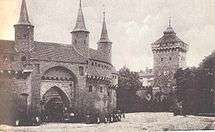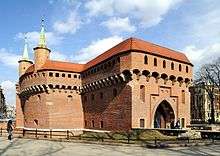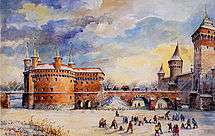Kraków Barbican
|
Historical Museum of the City of Krakow The Barbican | |
 | |
| Established | 1967 |
|---|---|
| Location | Kraków, Poland |
| Coordinates | 50°03′56″N 19°56′30″W / 50.06549°N 19.94164°WCoordinates: 50°03′56″N 19°56′30″W / 50.06549°N 19.94164°W |
| Type |
|
| Collection size |
|
| Visitors |
|
| Manager | Małgorzata Niechaj |
| Director | PL:Michał Niezabitowski |
| Curator | Małgorzata Niechaj |
| Public transit access | PL:Miejskie Przedsiębiorstwo Komunikacyjne w Krakowie how to get there, see external links |
| Website | http://www.mhk.pl/branches/barbican |
The Kraków Barbican (Polish: barbakan krakowski) is a barbican – a fortified outpost once connected to the city walls. It is a historic gateway leading into the Old Town of Kraków, Poland. The barbican is one of the few remaining relics of the complex network of fortifications and defensive barriers that once encircled the royal city of Kraków in the south of Poland.[1][2] It currently serves as a tourist attraction and venue for a variety of exhibitions.[3]
Today Barbican falls under the jurisdiction of The Historical Museum of the City of Kraków which has made it accessible for the tourists, who can tour its interior with outline of historical development of fortifications in Kraków.[4]
History
The Gothic-style barbican, built around 1498, is one of only three such fortified outposts still surviving in Europe, and the best preserved. It is a moated cylindrical brick structure with an inner courtyard 24.4 meters in diameter, and seven turrets. Its 3-meter-thick walls hold 130 embrasures. The barbican was originally linked to the city walls by a covered passageway that led through St. Florian's Gate and served as a checkpoint for all who entered the city.[5]
Features
Considered a masterpiece of medieval military engineering, the circular fortress of the Kraków's Barbakan was added to the city's fortifications along the coronation route in the late 15th century, based on Arabic rather than European defensive strategy.[3] On its eastern wall, a tablet commemorates the feat of a Kraków burgher, Marcin Oracewicz, who, during the Bar Confederation, defended the town against the Russians and shot their Colonel Panin.[6][7]
Gallery
 Kraków Barbican in the 1930s
Kraków Barbican in the 1930s Gate to the former fortified passage facing St. Florian's Gate to the south
Gate to the former fortified passage facing St. Florian's Gate to the south Kraków Barbican modern entrance
Kraków Barbican modern entrance Barbican's defensive walls and the connecting bridge from before their 19th century dismantlement
Barbican's defensive walls and the connecting bridge from before their 19th century dismantlement
See also
- Planty Park, which encircles Kraków's Old Town (Stare Miasto)
- Warsaw Barbican
Notes
- ↑ Ministry of Foreign Affairs 2002-2009, The Sites on the UNESCO List. Krakow, at Poland.gov.pl
- ↑ Jane Perlez, Cracow Emerges From the Shadows in the New York Times, July 18, 1993.
- 1 2 Mieczyslaw Kasprzyk, The Walls, Barbakan and the Florianska in "Krakow" from the Internet Archive
- ↑ Museum's History at the Museum's Home page (in Polish)
- ↑ This article incorporates information available at the Polish Wikipedia, including English text at Verbia - Guided tours of Krakow Archived 2008-05-31 at the Wayback Machine.
- ↑ Beata Moore, Cracow: City of Treasures, 112 pages. Published by Frances Lincoln, ISBN 0-7112-2571-0
- ↑ Kraków – City portrait Archived 2008-06-08 at the Wayback Machine. at Compress VerlagsgesmbH, Wien, Österreich
Bibliography
External links
![]()
- How to get there?
- Kraków Poland: information about and photographs of Kraków's Barbican